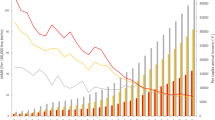Abstract
Objective: To review factors contributing to a 52% drop in Egypt’s maternal mortality ratio (MMR) per 100,000 live births from 174 in 1992–93 to 84 in 2000. Methods: Data on maternal mortality were collected from all 27 governorates in Egypt between 1 January and 31 December 2000. This round of maternal mortality data is compared with the earlier nation wide maternal mortality study in 1992. Health care interventions that may account for the decrease were reviewed. Results: MMR decreased by 51.7% nation wide. This decrease was greater in the less-developed parts of Upper Egypt (59%), than in Lower Egypt (30%). A multifaceted set of interventions were concentrated in Upper Egypt. The greatest decrease in maternal mortality was associated with the area of highest intervention, greatest need, and during the time period of the implementation of this program. There were increases in use of health services; use of modern contraceptives; hospital deliveries; and use of trained birth attendants. For most indicators, the changes were greater in Upper than Lower Egypt. Conclusion: Since 1992–93, efforts by the Government of Egypt and donors to improve access to and the quality and utilization of services can be linked to a greatly reduced MMR.
Similar content being viewed by others
References
World Health Organization. Revised 1990 estimates of maternal mortality. A new approach by WHO and UNICEF. WHO/FRH/MSM/96.11. Geneva: WHO, 1996.
World Bank. World development report: Investing in health. Oxford: Oxford University Press, 1993.
Benagiano G, Thomas B. Safe Motherhood: the FIGO Initiative. 2003;82:263–74.
Safe Motherhood and the World Bank: Lessons Learned From 10 Years Experience. The International Bank for Reconstruction and Development/the World Bank, 1999.
El Kady A, Loza SF, Abdel-Tawab N, Potter L. Practices and Maternal Mortality in Giza, Egypt (Final Report), Social Planning, Analysis and Administrative Consultants, 1998.
Fortney JA, Susanti I, Gadalla S, Saleh S. Reproductive mortality in two developing countries. Am J Public Health 1986;76:134–8.
Abdullah SA, Fathalla MF, Abdel Aleem AM, Salem HT, Aly MY. Maternal Mortality in Upper Egypt. Paper Presented at the WHO Inter-Regional Meeting on Prevention of Maternal Mortality, Geneva, 11–15 November 1985.
Ministry of Health. National Maternal Mortality Study: Egypt 1992–1993. Preliminary report of findings and conclusions. Cairo: MOH, 1994.
Ministry of Health and Population. Healthy Egyptians 2010. Maternal and child health objectives. Cairo: MOHP, 1997.
Healthy Mother/Healthy Child Results Package. Performance Milestone Report No. 32, Task 1. Cairo: John Snow Inc, 2001.
Ministry of Health and Population. Statistical report from the HIS/MOHP, 2000. Cairo: MOHP, 2001.
Ministry of Health and Population and National Population Council. In: El-Zanaty F, Way A, editors. Egypt Demographic Health Survey 2000. Calverton, Maryland: Macro International, 2001.
Directorate of Maternal and Child Health, Ministry of Health and Population. National Maternal Mortality Study: Egypt, 2000. Cairo: MOHP, 2001.
Central Agency for Public Mobilization and Statistics. Statistical yearbook. Cairo: CAPMAS, 2000.
Ministry of Health and Population. Statistical report from the HIS/MOHP. Cairo: Egypt 2000.
Wardlaw T, Maine D. Process indicators for maternal mortality programmes. In: Berer M, Sundari Ravindran TK, editors. Safe motherhood initiatives: Critical issues. Oxford, UK: Blackwell Science for Reproductive Health Matters, 1999;24–30.
Bergsjo P. What is the evidence for the role of antenatal care strategies in the reduction of maternal mortality and morbidity? In: van Lerberghe W, De Brouwere V, editors. Safe motherhood strategies: A review of the evidence, studies in health services organisation and policy, 2001;17:35–54.
Graham WJ, Bell JS, Bullough CHW. Can skilled attendance at delivery reduce maternal mortality in developing countries? In: van Lerberghe W, De Brouwere V, editors. Safe motherhood strategies: A review of the evidence, studies in health services organisation and policy, 2001;17:35–54.
Author information
Authors and Affiliations
Corresponding author
Rights and permissions
About this article
Cite this article
Gipson, R., Mohandes, A.E., Campbell, O. et al. The Trend of Maternal Mortality in Egypt from 1992–2000: An Emphasis on Regional Differences. Matern Child Health J 9, 71–82 (2005). https://doi.org/10.1007/s10995-005-3348-1
Issue Date:
DOI: https://doi.org/10.1007/s10995-005-3348-1




